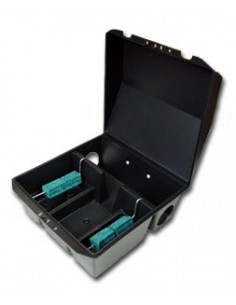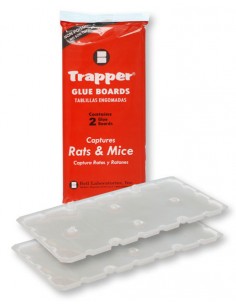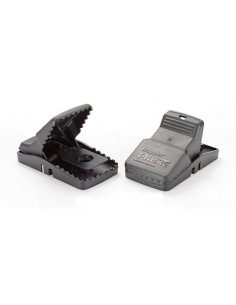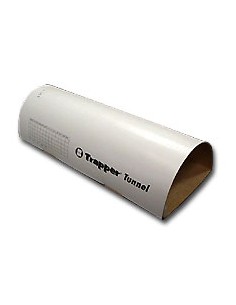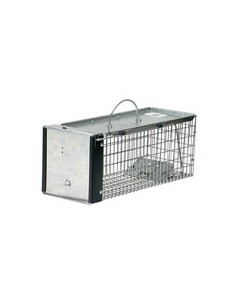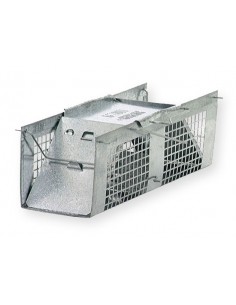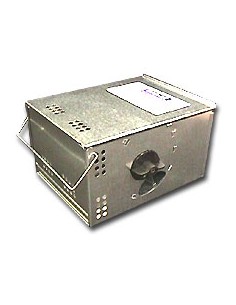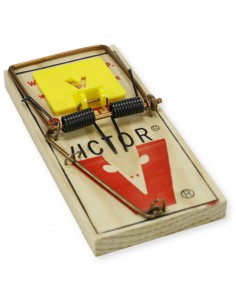Expert Help, Same-Day FREE Shipping & 60 Day Easy Returns - Since 1997
The Best Rat Trap - Rat Trap Review
Looking for the best rat trap to catch rats? Rat traps are designed for different areas and purposes. Indoor and outdoor trapping success depends on many factors. Choosing the correct and best rat trap for the situation is the first step......
What Is The Best Rat Trap?
The best rat trap to catch rats depends entirely on where the trap is to be placed. Indoor rat trapping is much different than outdoor trapping. In order to determine which rat trap is best, knowing all of the different styles and methods helps. Never place an old wooden snap style rat trap where children or pets can get to it. By comparison, glue board style rat traps can't be used outdoors. Outdoor trapping can be difficult, indoor trapping dangerous for children and pets. What do the pros do? Which rat trap is best? Knowing the different kinds of rat traps and the advantages / disadvantages of each will help in determining which trap to use and where to place it.
Best Rat Traps Available -
- Plastic Snap Rat Traps
- Multiple Catch Rat Traps
- Live Rat Traps
- Glue Board Rat Traps
- Wooden Snap Rat Traps
Plastic Snap Rat Traps
Trapper T-Rex Rat Snap Trap - The Trapper T-Rex Rat trap works very well at capturing rats while not being of any immediate danger to older children or pets. If they happen to trip the trap, it generally scares them while not doing any real damage to tiny fingers. How it works - Plastic rat traps work by suffocating the rat, not by a crushing blow from a thick heavy wire. After capture, the plastic lid squeezes tighter and tighter and the rat cannot breathe. As a result the rat suffocates - usually within minutes. The air literally gets squeezed out of it's lungs. If you plan on using plastic snap traps indoors, it is best to use them in a box with holes cut out on the sides or inside a rodent bait station. This is purely for safety reasons. Plastic rat traps are one of the safest and effective traps on the market. Safe enough in my opinion to use around older children and pets. Beware of quality issues. Some plastic rat traps are made from cheap brittle plastic and break easily. The Trapper T-Rex Rat Snap Trap is made in the USA and is of the highest quality. It's the plastic snap trap most commonly used by Professional Pest Control companies. 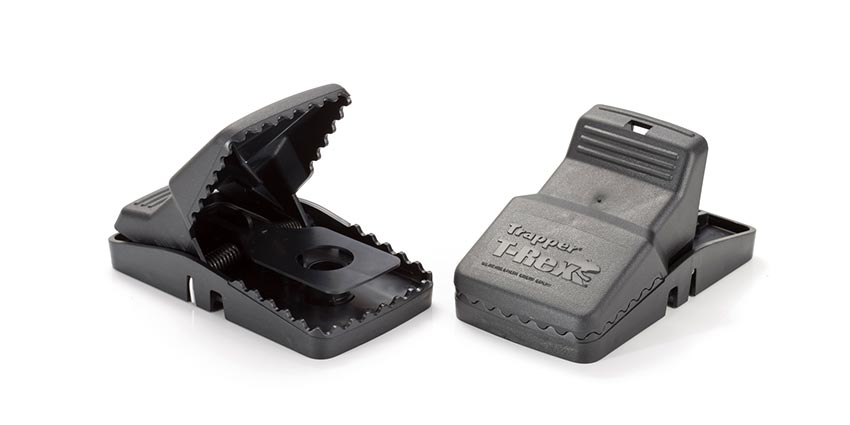
T Rex Rat Trap
Plastic Snap Rat Trap Advantages - Disposable, reusable, safer than spring traps, won't break fingers. Plastic Snap Rat Trap Disadvantages - More expensive than wooden snap traps. Plastic Snap Rat Trap Safety - Moderately safe around children and pets. Plastic Snap Rat Trap Indoor Use: Yes, safer to use around children and pets than wooden snap traps. Plastic Snap Rat Trap Outdoor Use: Yes, weather resistant. Recommended use in inside of a box or rodent bait station. Plastic Snap Rat Trap Tips: Secure the base with a screw or nail to a piece of wood or heavy object. Rats can sometimes drag them away to die.
Live Catch Rat Traps
Havahart Live Catch Rat Trap - Trapping live animals can be tricky. First - it takes "pre-baiting" in which the trap is wired open so that it can't close. Then it requires a careful plan of strategy to "catch" the rat. Live traps for rats are exactly the same as the larger animal traps for rabbits, skunks and squirrels. The Havahart Live Catch Rat Trap captures the rat alive so that it can be relocated and released to another area. How it works - the rat is lured into the trap by using a lure or food. When the rat enters the trap, it steps on a metal "trip" plate at the rear of the trap and releases a door. This seals the rat inside the trap so that it can't escape. Live rat trapping is difficult but can be accomplished. The problem with live trapping is that unlike snap traps, the rat has to enter the trap and walk across the "trip" plate to get to the lure. Some rats will wander into the trap without any thought and get trapped. Other rats are smart and will not enter the trap at all. These rats are said to be "trap shy". Live traps are generally larger than standard snap traps. The larger trap size can be more of an issue to the rat and can create "trap shyness". Live rat traps also create another problem - the rat is alive when captured. The rat has to then be relocated far enough away that it can't find it's way back. That usually means a trip in the car or truck to let it go somewhere. Live rat traps can work and be an effective part of a rat control program. But beware, it takes time and some patience to be successful. 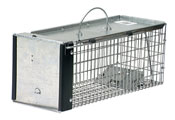
Live Catch Rat Trap Advantages - Captures rats and small animals alive. Havahart 07451 Live Animal Trap Live Catch Rat Trap Disadvantages - Large box is not easy to conceal. Live rats have to be released somewhere. Live Catch Rat Trap Safety - Safe for children and pets. If a pet is captured simply release it. Live Catch Rat Trap Indoor Use: No, not unless used in attics or crawl spaces. If used in these areas, be sure to check trap daily to make sure that any trapped animal has food and water. Never leave trapped animals in a hot attic in the summer. Live Catch Rat Trap Outdoor Use: Yes, suitable for outdoor use away from children and pets. Live Catch Rat Trap Tips: Use a piece of old carpet and place under the trap to collect urine and droppings. Use this piece of carpet on future trapping missions to attract other rats and animals. Be sure to wear gloves. Old carpet can be kept in a trash bag. Pre-bait live traps by wiring trap open and allowing rat to enter and leave at will. When the rat is trained to enter the trap, un-wire and start trapping.
Multiple Catch Rat Traps
Kness Ketch-all Multiple Catch Rat Trap - The 'Worlds Best Mousetrap", the Kness Ketch-all Multiple Catch Trap captures mice and smaller rats. It is not designed to capture large rats. The story behind this trap is that Mr. Kness developed it for his child's school in the early 1920's. The school had a mouse problem that they could not control. Mr. Kness, being an engineer, developed the world's first repeating mouse trap. As the story goes, it eliminated the mice and Kness Manufacturing was born. How it Works - Mice and small rats enter the trap through a side hole. After entering the trap, they step on a small "trip" plate that releases the entire floor and sweeps them into a holding chamber. This revolving floor is very gentle to mice and can capture several mice at the same time. The floor is similar to a "paddle wheel". This wheel is spring loaded and will reset itself. Up to 15 mice can be captured with 1 winding of the spring. A black spring knob is located on the outside of the trap. This knob is wound by hand several times to engage the spring. Today there are several manufacturers of Multiple Catch mouse traps. The Kness trap is still one of the best and most used by pest control companies. Most food preparation facilities, bakeries, restaurants and warehouses use these traps indoors. They can be placed ever 25-50 feet along walls and around doors There are also non-spring loaded multiple catch mouse traps such as the Tin Cat Mouse Trap. The Tin Cat Mouse Trap is only good at catching mice, it is too small for capturing rats. Basically, mice will enter the trap through an opening, and fall into the trap by means of a 1 way door. 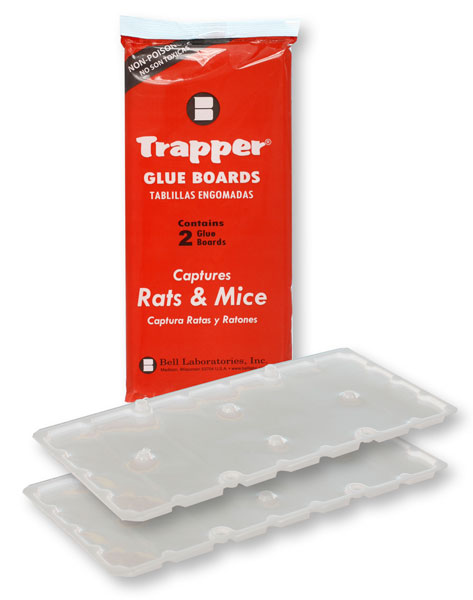 Trapper Glue Board For Rats
Trapper Glue Board For Rats
Glue Board Rat Trap Advantages - Disposable, works where snap traps and live traps don't. Glue Board Rat Trap Disadvantages - Glue. The glue gets dirty, and things get stuck in it. Can be very messy. Glue Board Rat Trap Safety: Not safe around children or pets. The heavy glue can cause all kinds of problems. Glue Board Rat Trap Indoor Use: Yes, only use indoors in protected areas. Glue Board Rat Trap Outdoor Use: No, not weather resistant. Glue Board Rat Trap Tips: If 1 trap doesn't work, place 2 or 3 traps end to end or side by side to capture running rats or mice. Glue Board Rat Trap Bait/Lure: None needed. These traps don't work that way. They capture running rodents along straight walls.
Wooden Snap Rat Traps
The Victor Classic Rat Trap - This is the original wooden rat trap with a heavy wire closure. It was designed hundreds of years ago and hasn't changed much today. Known as the "finger breaker", the original wooden rat trap works well. However, if misused or tampered with by human hands or pets, it will break fingers and paws. How it works - a heavy gauge wire is pulled back and locked on one side of the trap. When a rat steps on the yellow lure plate, the wire is released and instantly crushes the rat. The wire is very heavy and the spring is very strong on most of these traps. The force of impact is enough to crush and even smash the rat to death. This trap is especially dangerous to small children and small animals. It's basically a "snare" type snap trap that is totally unforgiving. Unless you need a lot of rat traps and can place them in areas away from unsuspecting children or pets, they are not recommended. 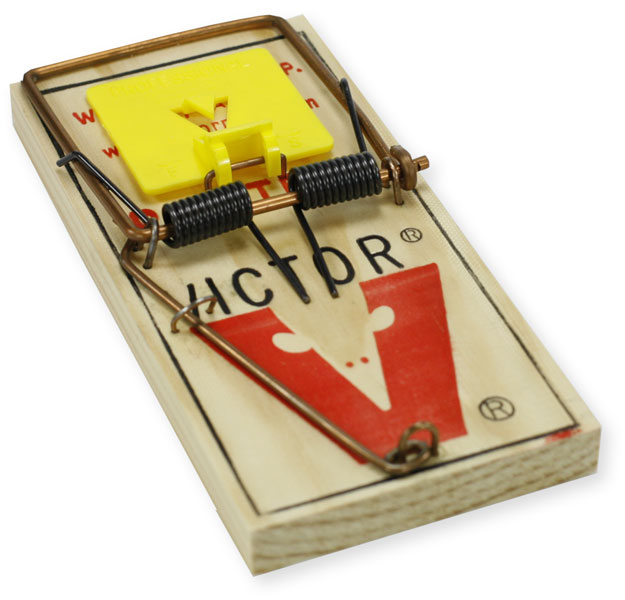
Wooden Snap Rat Trap Advantages - Inexpensive, easily disposable. Wooden Snap Rat Trap Disadvantages - Powerful spring action, heavy wire will break fingers, paws and legs of small animals, breaks easily. Wooden Snap Rat Trap Safety - Unsafe around children and pets. Wooden Snap Rat Trap Indoor Use: Yes, in protected areas only such as attics, locked closets. Wooden Snap Rat Trap Outdoor Use: No. Wood base will get wet and the trap will fall apart. Wooden Snap Rat Trap Tips: Use only if an inexpensive throwaway trap is needed.
Final Thoughts..... Unless you are willing to deal with a hostile rat, live trapping is not recommended. Releasing an angry rodent may sound easy, but there can be many issues to consider. Rats can escape and get away from traps easier than you think. Urine and dropping issues are also something to consider. Food, water and heat are also necessary to keep them alive. If live trapping is the preference you end up trying to do the "responsible" thing, beware of local laws and regulations. In many areas, relocation of wild animals is prohibited. Relocating to different counties can also be against the law. Be sure to check with your local animal control official before relocating any live rat. In some cases, they may even offer to come out and pick it up.
Recommended Rat Trap Products


